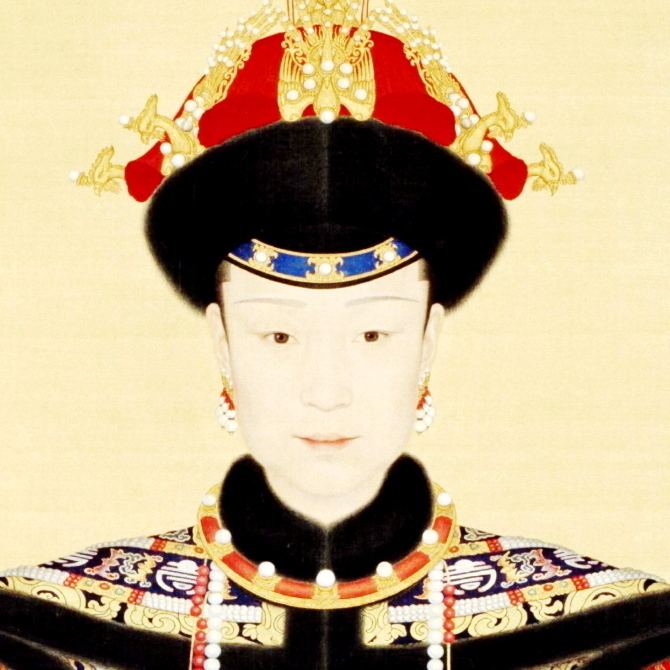Tenure 1737–1748 Father Fucha Lirongbao Died April 8, 1748 | Predecessor Empress Xiaoshengxian Name Empress Xiaoxianchun Successor Ulanara, the Step Empress | |
 | ||
Born 28 March 1712 ( 1712-03-28 ) Issue Qianlong Emperor's eldest daughterYonglianKurun Princess HejingYongcong Spouse Qianlong Emperor (m. 1727–1748) Children Crown Prince Duanhui, Prince Zhe of the First Rank, Kurun Princess Hejing Similar People | ||
Empress Xiaoxianchun (28 March 1712 – 8 April 1748) was the first Empress Consort of the Qianlong Emperor of the Qing dynasty.
Contents
Family background
Empress Xiaoxianchun was born in the Manchu Fucha (富察) clan, which was under the Bordered Yellow Banner of the Eight Banners. Her personal name is unknown. She was the eighth child of Lirongbao (李榮保), the Supervisor of Chahar Province.
Marriage to the Qianlong Emperor
In 1727 Lady Fucha married Hongli, the fourth son of the Yongzheng Emperor. She was granted the title of Primary Consort (嫡妃) of Hongli, who was then known as Prince Bao of the First Rank (寶親王), and moved into the Palace of Eternal Spring in the western part of the Forbidden City. In 1735 the Yongzheng Emperor died and was succeeded by Hongli, who became the Qianlong Emperor. Two years later in 1737 Qianlong instated Lady Fucha as his Empress.
As Empress
In the Draft History of Qing, Lady Fucha is depicted as a respected and virtuous person. She looked after the Qianlong Emperor and the people in the palace, and served her role as Empress well. She was praised and favoured by Qianlong.
It is also said that Lady Fucha did not like spending money for her own good. Instead of wearing jewellery she would put wild flowers in her hair.
The Qianlong Emperor once told her a story that Manchus were too poor to make their own pouches from cloth and had to settle for simple deer hide instead. She immediately made one for him. He was touched by the gift. Lady Fucha also made other pouches for him.
Lady Fucha took her duties seriously when it came to Confucian rituals. As head of the women's quarters in the palace, she supervised the emperor's concubines when performing a ritual. One of these was a rite concerning sericulture that was presided over by the Empress. This rite, which had been practiced since the Zhou dynasty, was gradually restored during the reign of the Qianlong Emperor. For this a sericulture altar was constructed in 1742.
In 1744 a new Altar to Sericulture was completed, largely at Lady Fucha's urging. In the same year Lady Fucha became the first empress in the Qing dynasty to personally lead the women in the palace in these rites. They made offerings of mulberry and presented them to silkworm cocoons, all of them working industriously.
The whole rite was painted on four scrolls in 1751 in memory of Lady Fucha, who died in 1748.
Death
Lady Fucha often joined the Qianlong Emperor on his excursions throughout China. In 1748, during one of Qianlong's southern tours, Lady Fucha became seriously ill and eventually died on 8 April at the age of 36. She was interred in the Yuling Mausoleum in the Eastern Qing Tombs. It is said that the Qianlong Emperor often visited her grave with wistful longing, and remained heartbroken to the end of his days.
Family
Empress Xiaoxianchun was born in an aristocratic family that saw many members serving as officials in the Qing imperial court.
Ancestors and elders
Siblings
Lady Fucha had seven older brothers, two younger brothers and several sisters. The most notable of her siblings was a younger brother, Fuheng.
Issue
Lady Fucha bore the Qianlong Emperor two sons and two daughters, of whom only one daughter survived to adulthood.
Posthumous title
Empress Xiaoxianchun's full posthumous title is:
(孝賢誠正敦穆仁惠徽恭康順輔天昌聖純皇后)
